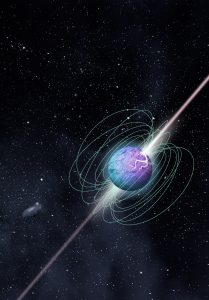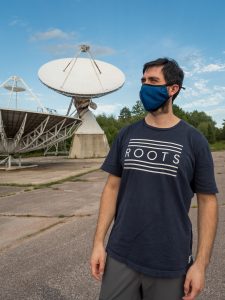FOR IMMEDIATE RELEASE November 04, 2020
New data from a Canadian-led team of astronomers – including researchers from the Dunlap Institute for Astronomy & Astrphysics and the University of Toronto – strongly suggests that magnetars – a type of neutron star believed to have an extremely powerful magnetic field – could be the source of certain fast radio bursts (FRBs).
On April 28, 2020,a team of about 50 students, postdocs, and professors from the Canadian Hydrogen Intensity Mapping Experiment (CHIME) Fast Radio Burst Collaboration detected an unusually intense radio burst from a nearby magnetar in the Milky Way. In a study published today in Nature this team shows that the intensity of the radio burst was three thousand times greater than that of any magnetar measured thus far – lending weight to the theory that magnetars are at the origin of at least some FRBs.
Now, as lead author and Dunlap Institute Fellow Dr. Paul Scholz explains, the research team has a better sense of what to look for. “Given the large gaps in energetics and activity between the brightest and most active FRB sources and what is observed for magnetars, perhaps younger, more energetic and active magnetars are needed to explain all FRB observations,” Scholz explains.
In addition to their contributions as part of the Collaboration, astronomers at the Dunlap Institute, the University of Toronto, and the Canadian Institute for Theoretical Physics (CITA), can be credited with a special portion of this discovery. The radio burst was seen through not only through the CHIME telescope, but also through the 10-Metre Telescope at the Algonquin Radio Observatory (ARO) – which was primarily constructed by astronomers at the University of Toronto. Because of these instruments working in tandem, the team was able to confirm that the discovery was truly astrophysical.
“It’s incredible that the 10-metre telescope has just been turned on, and is already able to work with CHIME to become part of a massive discovery,” said Dr. Mubdi Rahman, Research Associate at the Dunlap Institute.
 Tomás Cassanelli, a graduate student in the David A. Dunlap Department of Astronomy and Astrophysics who led in the re-development of ARO’s 10-metre telescope, says he’s excited about future implications for these telescopes to work together. “Future simultaneous observations will also help us find the host galaxies of future FRBs.”
Tomás Cassanelli, a graduate student in the David A. Dunlap Department of Astronomy and Astrophysics who led in the re-development of ARO’s 10-metre telescope, says he’s excited about future implications for these telescopes to work together. “Future simultaneous observations will also help us find the host galaxies of future FRBs.”
FRBs were first discovered over a decade ago. Originally thought to be singular events, astronomers have since discovered that some of these high-intensity blasts of radio emissions do, in fact, repeat. Until now, all of the FRBs that telescopes like CHIME have picked up were in other galaxies, which made them quite hard to study in great detail.
But now, as lead author and Dunlap Institute Fellow Dr. Paul Scholz explains, the research team has a better sense of what to look for. “Given the large gaps in energetics and activity between the brightest and most active FRB sources and what is observed for magnetars, perhaps younger, more energetic and active magnetars are needed to explain all FRB observations,” Scholz explains.
About this study
“A bright millisecond-duration radio burst from a Galactic magnetar,” by the CHIME/FRB Collaboration, was published in Nature .
The research was funded by:
The CHIME/FRB Project is funded by a grant from the Canada Foundation for Innovation (CFI), the Provinces of British Columbia and Québec, and the Dunlap Institute for Astronomy and Astro-physics at the University of Toronto. Additional support was provided by the Canadian Institute for Advanced Research (CIFAR), McGill University and the McGill Space Institute via the Trottier Family Foundation, and the University of British Columbia. CHIME is funded by a grant from the CFI Leading Edge Fund and by contributions from the provinces British Columbia, Quebec and Ontario. The Dunlap Institute is funded by an endowment established by the David Dunlap family and the University of Toronto. Research at Perimeter Institute is supported by the Government of Canada through Innovation, Science and Economic Development Canada and by the Province of Ontario through the Ministry of Research & Innovation. The National Radio Astronomy Observatory is a facility of the National Science Foundation operated under cooperative agreement by Associated Universities, Inc.
Additional funds were received from the Fonds de Recherche Nature et Technologie Québec (FRQNT), a Killam Fellowship, an NSERC Discovery Grant, CIFAR, the FRQNT Centre de Recherche en Astrophysique du Quebec (CRAQ), the Canada Research Chairs program, NSF, the Lorne Trottier Chair in Astrophysics & Cosmology, a Distinguished James McGill Professorship, an NSERC Discovery Grant, a Gerhard Herzberg Award, an R. Howard Webster Foundation Fellowship from CIFAR, a Banting Postdoctoral Fellowship, an NSF Physics Frontiers Center award, the Ontario Research Fund—research Excellence Program (ORF-RE), the Simons Foundation, the Alexander von Humboldt Foundation, a Schulich Graduate Fellowship from McGill University, a Dunlap Fellowship and an NSERC Postdoctoral Fellowship.
About the CHIME Fast Radio Burst Collaboration
CHIME/FRB is a collaboration of over 50 scientists led by McGill University, University of British Columbia, the University of Toronto, the Perimeter Institute for Theoretical Physics, and the National Research Council of Canada (NRC). The $16-million investment for CHIME was provided by the Canada Foundation for Innovation and the governments of British Columbia, Ontario and Quebec, with additional funding from the Dunlap Institute for Astronomy and Astrophysics, the Natural Sciences and Engineering Research Council and the Canadian Institute for Advanced Research. The telescope is located in the mountains of British Columbia’s Okanagan Valley at the NRC’s Dominion Radio Astrophysical Observatory near Penticton. CHIME is an official Square Kilometre Array (SKA) pathfinder facility.
For more information, please contact:
Meaghan MacSween
Communications and Multimedia Officer
Dunlap Institute for Astronomy and Astrophysics,
University of Toronto
meaghan.macsween@dunlap.utoronto.ca
The Dunlap Institute for Astronomy & Astrophysics at the University of Toronto is an endowed research institute with more than 70 faculty, postdocs, students and staff, dedicated to innovative technology, ground-breaking research, world-class training, and public engagement. The research themes of its faculty and Dunlap Fellows span the Universe and include: optical, infrared and radio instrumentation; Dark Energy; large-scale structure; the Cosmic Microwave Background; the interstellar medium; galaxy evolution; cosmic magnetism; and time-domain science. The Dunlap Institute for Astronomy and Astrophysics, David A. Department of Astronomy & Astrophysics and the Canadian Institute for Theoretical Astrophysics comprise the leading centre for astronomical research in Canada, at the leading research university in the country, the University of Toronto.
